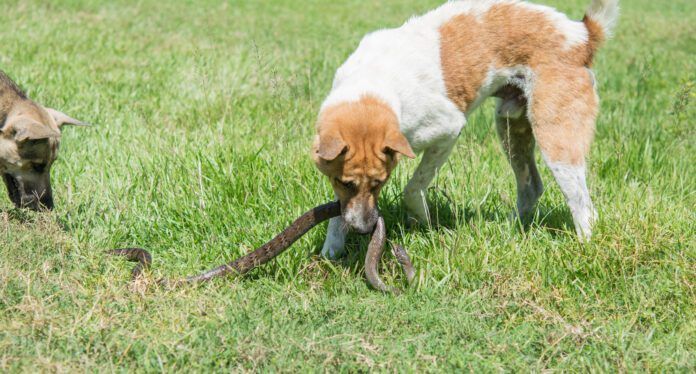The dog snake bite timeline usually starts like this: You’re walking through the woods, and your dog is off exploring. Suddenly, he yelps, and you see a snake slithering away (possibly causing you to also yelp!). Venomous snakes can be found everywhere in North America. Was THAT snake poisonous?
Do not panic. If you panic, your dog will stress, which increases his blood pressure and moves any injected venom faster into his body. Remember, most dogs survive even venomous snake bites, and it’s possible your dog got a “dry bite,” which means no venom was expressed.
Snake bites can usually be identified by the bite itself. In general, nonpoisonous snake bites show horseshoe-shaped teeth marks, while poisonous snake bites tend to have one or two puncture marks from fangs, and they may be bleeding.
Symptoms of a snake bite in a dog can vary with the type of snake. Nonpoisonous snake bites often do not swell or cause pain and require basic first aid. Venomous bites, however, tend to be extremely painful and are usually accompanied by rapid swelling.
In general, signs of venom poisoning include:
- Restlessness
- Diarrhea
- Panting
- Drooling
- Wobbly gait
- Vomiting
- Shallow breathing
- Shock
- Death
Dog Snake Bite Identification
If your dog was bitten by a snake, head back to your car or home, quickly but calmly. Don’t waste time trying to identify or capture the snake. If it was a coral snake, you would know immediately by the bright coloration. The “big three” snakes can all look similar, and they are rattlesnakes, copperheads, and water moccasins. Fortunately, the same antivenom is used with all the “big three” snakes.
The venom of coral snakes, however, has neurotoxins and can lead to paralysis. Treatment for their bites requires special antivenom, which is why it’s helpful if you notice bright coloration on the snake. Not every veterinary clinic has it.
Emergency Protocol for Snake Bite in Dogs
Call your local veterinary clinic or emergency clinic to see if they have antivenom available. If not, ask them to track a source down so you know where to go. Again, don’t panic, for the common venomous snakes in North America, you almost always have some time, not just minutes like you see on some Western tv shows.
Do not put on a tourniquet or try to suck the venom out. You might do some harm and, if nothing else, you are wasting valuable travel time. Icing, antihistamines, and steroids are all on the list of things NOT to do for snake bites in dogs. If your dog was bitten on the face or neck, remove the dog’s collar because there may be swelling.
Antivenom is expensive, but it is the best chance for minimal permanent damage to your dog. Plus, especially for a small dog, it might be the difference between life and death. Your dog will usually be kept at the veterinary hospital for observation and bloodwork to evaluate him. Oxygen may be required if he has swelling in his face and/or neck.
Fortunately, most dog-snake encounters are with nonvenomous snakes such as garter snakes and black snakes or black racers. These are helpful snakes that eat rodents. If your dog attacks one, however, he might get bitten and the bite is painful.
If you find your dog hunting, catching and killing snakes, check for bite wounds. Wash any wound out thoroughly, with lots of water, saline solution, or dilute chlorhexidine solution. Observe for redness that might indicate an infection brewing. My Cirneco dell Etna, Tux, hunts snakes to my dismay (I like snakes and want our good snakes left alone!). So far, he has dispatched a number of snakes with no bites.
Avoid Snake Bites in Dogs
How to avoid snake bites? If you live in an area with numerous venomous snakes, consider having snake-aversion training. Ask your veterinarian or local dog club for reputable trainers.
Remember that snakes are not out hunting you or your dog. Given the option, they will leave. So be aware of the possibility of spotting a snake on hikes and, if you spot one, detour well around it. Check with local parks where you hike for the best times and ways to avoid snake contacts.







Pictures of venomous v. non-venomous bits would be helpful.
I wish more was shared on ‘snake aversion training’ in this article. Even another sentence that states this can be done without shock. Most will read those few written words and call their vet for a shock collar trainer. As someone who lives in an area with the three main culprits, I can attest that shock collar training is not the ‘fix’ that everyone thinks it is. My clients have lost their dogs because of this type of training or had dogs that were afraid of hoses, sticks, etc. Most veterinarians in my area don’t have a resource for R+ snake avoidance training and will immediately promote shock trainers. I appreciate the article link but many will not click on it.